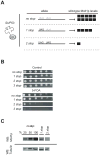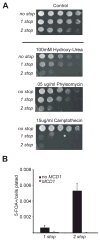Systematic reduction of cohesin differentially affects chromosome segregation, condensation, and DNA repair
- PMID: 20451387
- PMCID: PMC2892909
- DOI: 10.1016/j.cub.2010.04.018
Systematic reduction of cohesin differentially affects chromosome segregation, condensation, and DNA repair
Abstract
Cohesin's complex distribution on chromosomes and its implication in numerous cellular processes makes it an excellent paradigm for studying the relationship between the in vivo concentration of a protein and its in vivo function. Here, we report a method to generate systematic quantized reductions (QR) in the in vivo concentration of any yeast protein. With QR, we generate strains with 13% and 30% of wild-type levels of the limiting subunit of cohesin, Mcd1p/Scc1p/Rad21p. Reducing cohesin levels reveals a preferential binding of cohesin to pericentric regions over cohesin-associated regions (CAR) on chromosome arms. Chromosome condensation, repetitive DNA stability, and DNA repair are compromised by decreasing cohesin levels to 30% of wild-type levels. In contrast, sister-chromatid cohesion and chromosome segregation are unaffected even when cohesin levels are reduced to 13% of wild-type levels. The requirement for different in vivo cohesin concentrations to achieve distinct cohesin functions provides an explanation for how cohesin mutations can specifically lead to adult disorders such as Cornelia de Lange Syndrome and Roberts Syndrome without compromising the cell divisions needed for development and maturation. Our successful application of QR to cohesin suggests that QR is a powerful tool to study other proteins/pathways with multiple functions.
Copyright 2010 Elsevier Ltd. All rights reserved.
Figures




Similar articles
-
ROCC, a conserved region in cohesin's Mcd1 subunit, is essential for the proper regulation of the maintenance of cohesion and establishment of condensation.Mol Biol Cell. 2014 Aug 15;25(16):2351-64. doi: 10.1091/mbc.E14-04-0929. Epub 2014 Jun 25. Mol Biol Cell. 2014. PMID: 24966169 Free PMC article.
-
Cohesin architecture and clustering in vivo.Elife. 2021 Feb 17;10:e62243. doi: 10.7554/eLife.62243. Elife. 2021. PMID: 33594972 Free PMC article.
-
Cohesin Function in Cohesion, Condensation, and DNA Repair Is Regulated by Wpl1p via a Common Mechanism in Saccharomyces cerevisiae.Genetics. 2018 Jan;208(1):111-124. doi: 10.1534/genetics.117.300537. Epub 2017 Nov 20. Genetics. 2018. PMID: 29158426 Free PMC article.
-
The expanding phenotypes of cohesinopathies: one ring to rule them all!Cell Cycle. 2019 Nov;18(21):2828-2848. doi: 10.1080/15384101.2019.1658476. Epub 2019 Sep 13. Cell Cycle. 2019. PMID: 31516082 Free PMC article. Review.
-
Chromosome cohesion - rings, knots, orcs and fellowship.J Cell Sci. 2008 Jul 1;121(Pt 13):2107-14. doi: 10.1242/jcs.029132. J Cell Sci. 2008. PMID: 18565823 Review.
Cited by
-
Cohesin subunit RAD21: From biology to disease.Gene. 2020 Oct 20;758:144966. doi: 10.1016/j.gene.2020.144966. Epub 2020 Jul 17. Gene. 2020. PMID: 32687945 Free PMC article. Review.
-
Of Rings and Rods: Regulating Cohesin Entrapment of DNA to Generate Intra- and Intermolecular Tethers.PLoS Genet. 2016 Oct 27;12(10):e1006337. doi: 10.1371/journal.pgen.1006337. eCollection 2016 Oct. PLoS Genet. 2016. PMID: 27788133 Free PMC article. Review.
-
Recurrent mutations in multiple components of the cohesin complex in myeloid neoplasms.Nat Genet. 2013 Oct;45(10):1232-7. doi: 10.1038/ng.2731. Epub 2013 Aug 18. Nat Genet. 2013. PMID: 23955599
-
Chl1 DNA helicase regulates Scc2 deposition specifically during DNA-replication in Saccharomyces cerevisiae.PLoS One. 2013 Sep 26;8(9):e75435. doi: 10.1371/journal.pone.0075435. eCollection 2013. PLoS One. 2013. PMID: 24086532 Free PMC article.
-
The cohesin loader SCC2 contains a PHD finger that is required for meiosis in land plants.PLoS Genet. 2020 Jun 9;16(6):e1008849. doi: 10.1371/journal.pgen.1008849. eCollection 2020 Jun. PLoS Genet. 2020. PMID: 32516352 Free PMC article.
References
-
- Onn I, Heidinger-Pauli JM, Guacci V, Unal E, Koshland DE. Sister chromatid cohesion: a simple concept with a complex reality. Annu Rev Cell Dev Biol. 2008;24:105–129. - PubMed
-
- Liebman SW, Srodulski Z, Reed CR, Stewart JW, Sherman F, Brennan G. Yeast amber suppressors corresponding to tRNA3Leu genes. J Mol Biol. 1984;178:209–226. - PubMed
-
- Little JW. Mutants of bacteriophage T4 which allow amber mutants of gene 32 to grow in ochre-suppressing hosts. Virology. 1973;53:47–59. - PubMed
-
- Michaelis C, Ciosk R, Nasmyth K. Cohesins: chromosomal proteins that prevent premature separation of sister chromatids. Cell. 1997;91:35–45. - PubMed
Publication types
MeSH terms
Substances
Grants and funding
LinkOut - more resources
Full Text Sources
Other Literature Sources
Molecular Biology Databases

